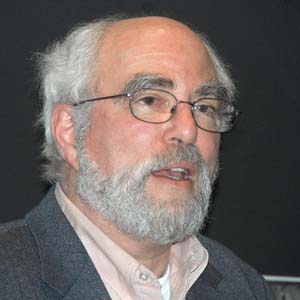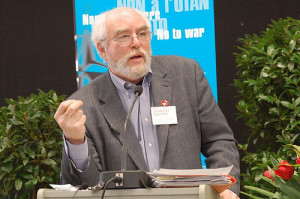THE UKRAINE WAR A YEAR FROM NOW: A REALIST CASE FOR CEASEFIRE & NEGOTIATIONS
Joseph Gerson
Text of speech given on the International Peace Bureau’s webinar, Feb. 24, 2024
I don’t have a crystal ball, and I can’t promise accurate predictions about the state of the Ukraine War a year from today. Three things that we do know are first, that Russia will continue fighting until it secures Ukrainian neutrality, and it will resort to any means necessary to prevent what U.S. General Austin has named as the ambition of winning Russia’s strategic defeat. Second, recently re-forged Ukrainian nationalism will continue to resist Russian domination then and in one way or another for decades to come. And, finally, as was the case before Russia’s invasion, Ukraine will have no chance of joining NATO.
Let me begin by saying that if Ukraine continues to reject neutrality and ceasefire negotiations, it jeopardizes its great 2022 victories and the future sovereignty of Ukraine. While we can’t discount the influence of Putin’s ambition to restore the Russian empire, before the Russian invasion and during the Istanbul negotiations, diplomacy then and now could lead to a mutually acceptable agreement: guarantees of a secure, neutral and sovereign buffer state in Ukraine, albeit without about 18% of its 1991 boundaries. That is the reality of what we can hope and work for a year from now.
It is worth noting that prior to the Russian invasion many in the Ukrainian western oriented elite would have been happy to see much of Russian speaking and oriented eastern Ukraine secede. It would have left a more ethnically homogeneous western Ukraine to pursue its ambitions with the EU and the West. Putin’s invasion counter-productively has consolidated a revised version of Ukrainian nationalism which is self-defeatingly insisting on conquest of the more Russian-oriented territories.
What will we see in a year? We could be in the first stages of a Trump dictatorship, with accommodations being made to Moscow at Ukrainian expense. Other dimensions of that dictatorship would include implementing plans for a US military mobilization to deport hundreds of thousands, possibly millions, of immigrants from the U.S. The current fragile détente with China would be a memory as Trump ratchets up his racist military and economic confrontation with China. Policies and diplomacy designed to halt and reverse the climate emergency would be similarly shredded. And the liberty, human rights, and processes ostensibly guaranteed by our flawed constitution would be in serious jeopardy and would be the focus of widespread opposition and resistance. These would not be Ukrainian events, but they would certainly impact the war’s geopolitical contexts.
On the other hand, fear of dictatorship here could lead to Biden’s reelection and the continued rule of what has become in large measure the Democratic war party. In such case, weapons and treasure from the U.S. would again be deluging Ukraine and its increasingly divided political and military leadership.
Almost a year ago, General Milley announced that the Ukraine war was stalemated and that neither side could obtain a military victory. General Austin, the Chairman of the Joint Chiefs, has yet to rescind his statement that US/NATO goal is strategic defeat of Russia. That goal is unachievable, but in the absence of a ceasefire and diplomacy, it remains Washington’s articulated goal. Here in the U.S., much of our media is broadcasting that in the absence of renewed weapons supplies Ukraine faces defeat and that the Baltics and even Poland faces possible Russian invasions.
That won’t be happening. 95% of Russian conventional forces are now tied down in Ukraine, and to conquer Ukraine the Russian military would have to engage in massively more difficult urban warfare at a perilous cost to its forces. It has been reported that even to take Advikiva Russia lost 1,000 troops a day, not a sustainable way to fight a war. And, with its conventional military capacities not approaching what was expected of a superpower, Moscow’s arsenal is running low, and with Finnish and Swedish integration into NATO, Russia will be focusing on rebuilding its conventional forces and concentrating on a defensive strategy in relation to NATO for the next decade or more.
While in the near term, Russian economic and diplomatic dependence on China remains essential for Moscow, serving as China’s junior partner will be less appealing for the longer term. With its sparse population and lack of economic development, Moscow’s hold over what was formerly Chinese territory in Sibera is less than secure. Moscow may prove to have greater fish to fry with China than launching a catastrophic and self-defeating war against NATO, even if Trump’s America Firsters withhold their support for Europe.
What Else Might We See?
In all probability, Ukraine and Russia will still be at war even in the first months of a possible Trump rule. In such case, as we see from recent commitments made by Britain, France, and Germany, European support for Ukraine would be significantly increased to support what of necessity is becoming Ukraine’s defensive strategy.
In any case, it seems that subservient Congressional Republicans will continue to kowtow to Trump, depriving Ukraine of US weapons and financial support, which would increase the burden on Europe to support Kyiv.
Two major contingencies should not be ruled out:
As we have seen since the beginning of the war, there remains the possibility of horizontal or vertical escalation in a desperate effort to break the stalemate or in response to an unexpected breakthrough by either side. Incidents, unintended or manufactured by one or another party, remain a possibility with the Russians especially concerned about Kaliningrad and aggressive forces in Poland. There also remains the possibility of Kyiv responding to Russia’s renewed offensives by acquiring and launching longer range and more devastating missiles against Russia itself. This, in turn, would precipitate a still more dangerous and difficult to control escalation spiral.
Former President and now deputy head of Putin’s security council Dmitry Medvedev appears to be addicted to the U.S. playbook for preparing and threatening nuclear attacks midst international crises and wars. His repeated nuclear threats have helped to unleash increasing numbers of calls in the Russian media, and even in the Russian parliament, to end the nagging “special military operation” with terrorizing nuclear attacks against Ukraine. We can hope that a year from now they will not have led us all across the nuclear threshold.
There is another question about Ukrainian unity. The fantasy of reconquering the 18% of 1991 Ukraine currently held by Russia still has a powerful hold on the minds of most Ukrainians. But some in the elite are recognizing the stalemate, and this has unsettled Zelensky. He just fired army chief Zaluzhnyi who named the stalemate and reportedly engaged in back-channel explorations with the Russian military to bring the war to a mutually beneficial end. These, and not the failures of the counter-offensive, are the reasons he was ousted.
Zelensky has also had to retreat from plans to augment his exhausted and depleted army by drafting another 50,000 civilians for the war. Apparently, few are willing to be the last man or woman die for 18% of historic Ukraine. And this will shape the war as 2025 begins.
In such circumstances, especially if Ukrainian forces suffer shocking battle losses, the Ukraine elite, including some in the military may see writing on wall. They could move to replace Zelensky to pursue negotiations with Russia for a neutral state with the possibility of E.U. membership.
There is more to the war than centuries of Russian-Ukrainian tensions: profound great power geostrategic competition and struggle. The U.S. National Security Strategy tells us that the Post-Cold War era is past, over, kaput, and that the contest is under way to shape what will follow. The so-called “rules-based order” – a disorder that was frequently violated by the U.S. and its allies — was written to advantage U.S. and to a lesser extent Western European and Japanese elites. Russia, China, and the Global South were left out of the rules making process. Over the past 75 years, with the rise of China and post-colonial development in the Global South, the economic, technological, diplomatic, and political foundations of U.S. global hegemony have atrophied, and new power centers demanding their share of the pie have emerged.
It is impossible to know the degree to which Russian imperial ambitions, and as Boris Kagarlitsky has taught us, efforts to revitalize popular support for the Putin regime played roles in Putin’s decision to go to war. But it is certain that NATO’s expansion which exposed deep Russian security vulnerabilities played a central role. Russia’s invasion was an assault on the rules-based order, not only to ensure the country’s western periphery. It was also a catalyst designed to serve as a shock leading to the revision of global disorder.



